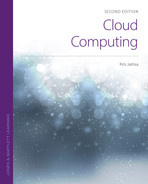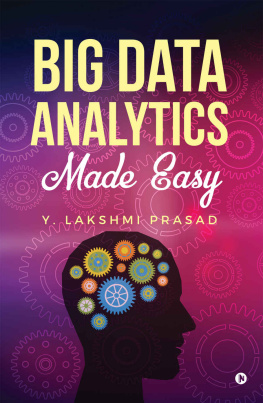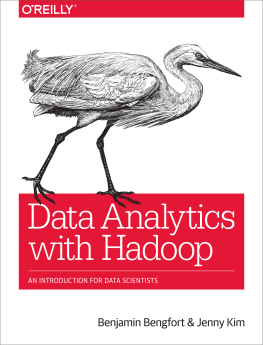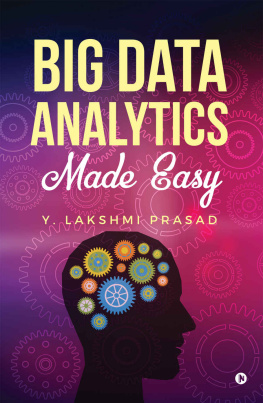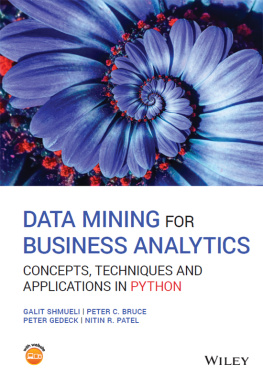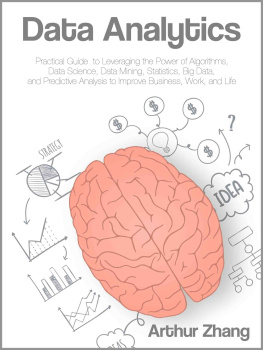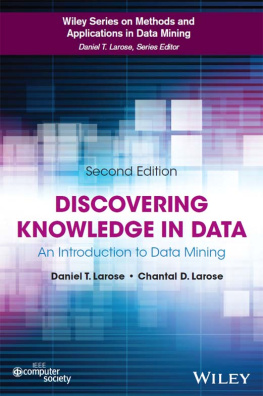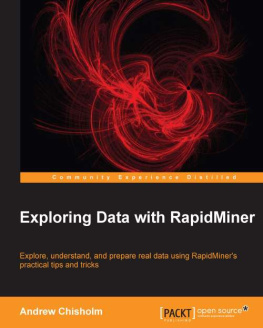Kris Jamsa - Introduction to Data Mining and Analytics
Here you can read online Kris Jamsa - Introduction to Data Mining and Analytics full text of the book (entire story) in english for free. Download pdf and epub, get meaning, cover and reviews about this ebook. year: 2021, publisher: Jones & Bartlett Learning LLC, genre: Politics. Description of the work, (preface) as well as reviews are available. Best literature library LitArk.com created for fans of good reading and offers a wide selection of genres:
Romance novel
Science fiction
Adventure
Detective
Science
History
Home and family
Prose
Art
Politics
Computer
Non-fiction
Religion
Business
Children
Humor
Choose a favorite category and find really read worthwhile books. Enjoy immersion in the world of imagination, feel the emotions of the characters or learn something new for yourself, make an fascinating discovery.

- Book:Introduction to Data Mining and Analytics
- Author:
- Publisher:Jones & Bartlett Learning LLC
- Genre:
- Year:2021
- Rating:3 / 5
- Favourites:Add to favourites
- Your mark:
- 60
- 1
- 2
- 3
- 4
- 5
Introduction to Data Mining and Analytics: summary, description and annotation
We offer to read an annotation, description, summary or preface (depends on what the author of the book "Introduction to Data Mining and Analytics" wrote himself). If you haven't found the necessary information about the book — write in the comments, we will try to find it.
Introduction to Data Mining and Analytics — read online for free the complete book (whole text) full work
Below is the text of the book, divided by pages. System saving the place of the last page read, allows you to conveniently read the book "Introduction to Data Mining and Analytics" online for free, without having to search again every time where you left off. Put a bookmark, and you can go to the page where you finished reading at any time.
Font size:
Interval:
Bookmark:

World Headquarters
Jones & Bartlett Learning
5 Wall Street
Burlington, MA 01803
978-443-5000
www.jblearning.com
Jones & Bartlett Learning books and products are available through most bookstores and online booksellers. To contact Jones & Bartlett Learning directly, call 800-832-0034, fax 978-443-8000, or visit our website,www.jblearning.com.
Substantial discounts on bulk quantities of Jones & Bartlett Learning publications are available to corporations, professional associations, and other qualified organizations. For details and specific discount information, contact the special sales department at Jones & Bartlett Learning via the above contact information or send an email to .
Copyright 2021 by Jones & Bartlett Learning, LLC, an Ascend Learning Company
All rights reserved. No part of the material protected by this copyright may be reproduced or utilized in any form, electronic or mechanical, including photocopying, recording, or by any information storage and retrieval system, without written permission from the copyright owner.
The content, statements, views, and opinions herein are the sole expression of the respective authors and not that of Jones & Bartlett Learning, LLC. Reference herein to any specific commercial product, process, or service by trade name, trademark, manufacturer, or otherwise does not constitute or imply its endorsement or recommendation by Jones & Bartlett Learning, LLC and such reference shall not be used for advertising or product endorsement purposes. All trademarks displayed are the trademarks of the parties noted herein. Introduction to Data Mining and Analytics is an independent publication and has not been authorized, sponsored, or otherwise approved by the owners of the trademarks or service marks referenced in this product.
There may be images in this book that feature models; these models do not necessarily endorse, represent, or participate in the activities represented in the images. Any screenshots in this product are for educational and instructive purposes only. Any individuals and scenarios featured in the case studies throughout this product may be real or fictitious, but are used for instructional purposes only.
17830-2
Production Credits
Director of Product Management: Laura Pagluica
Product Manager: Edward Hinman
Product Assistant: Melissa Duffy
Product Coordinator: Paula Yuan-Gregory
Tech Editor: Robert Shimonski
Senior Project Specialist: Dan Stone
Digital Project Specialist: Angela Dooley
Marketing Manager: Michael Sullivan
Product Fulfillment Manager: Wendy Kilborn
Project Management: codeMantra U.S., LLC
Cover Design: Scott Moden
Text Design: Scott Moden
Senior Media Development Editor: Troy Liston
Rights Specialist: Rebecca Damon
Cover Image (Title Page, Part Opener, Chapter Opener):
Patra Kongsirimongkolchai / EyeEm / Getty Images
Printing and Binding: LSC Communications
Library of Congress Cataloging-in-Publication Data
Library of Congress Cataloging-in-Publication Data unavailable at time of printing.
LCCN: 2019955670
6048
Printed in the United States of America
24 23 22 21 20 10 9 8 7 6 5 4 3 2 1

Patra Kongsirimongkolchai/EyeEm/Getty Images
Debbie,
You are the love of my life

Patra Kongsirimongkolchai/EyeEm/Getty Images
This textbook is accompanied by a Navigate 2 Premier Course that includes access to a Cloud Desktop with lab exercises. Cloud Desktops are browser-based lab environments where students have a chance to extend their learning beyond the textbook with real software on live virtual machines. Visit go.jblearning.com/JamsaData to learn more.

Patra Kongsirimongkolchai/EyeEm/Getty Images
Data analysts are dealing with more data today than ever before, and conservatively, that amount of data will continue to double every two years for many years to come. With ever-growing amounts of data come many opportunities for discovery. However, as the volume of data increases, so too do the challenges of discovering trends and patterns, as well as expressing such findings in a meaningful way to others. To store, analyze, and visualize data, analysts use SQL, NoSQL, and graph databases; Excel; data-mining tools; and machine-learning as well as big-data tools. This book examines these concepts and tools, introducing each and then using hands-on instruction to develop the skills you will need to perform real-world data-mining and analytic operations. Machine-learning and data-mining operations normally make extensive use of Python and R programming. As such, this book uses each. If you have not programmed before, relax - this book presents the programming skills you will need and introduces Visual Programming environments, such as Weka, Orange, and RapidMiner, which let you perform data mining and machine learning without having to write code!
, machine-learning solutions solve complex problems by using data to drive discovery, using only a few lines of code.
drills deeper into machine learning, the use of data pattern recognition algorithms to solve problems. Developers classify machine-learning algorithms as supervised, unsupervised, reinforced, and deep learning. Supervised learning is the use of an algorithm that uses labeled data to produce a training data set an algorithm can use to learn how to identify patterns. Common solutions that use supervised learning include data classification. Unsupervised learning is the use of an algorithm to identify patterns within data that do not have labeled elements that can be used to create a training data set. Common solutions that use unsupervised learning include data clustering and data association. Reinforced learning is the use of feedback loops to reward correct predictions and to punish mistakes. Finally, deep learning is a hierarchically structured process that leverages layers of machine learning, for which the output of one layer becomes the input to the next in order to drill down into a lower-level result.
examines databases, data warehouses, and data lakes. At the heart of most data applications are databases. Whether an application analyzes big data, mines data using machine learning, or drives real-time dashboards, data are at the center of the processing performed. For the past 50 years, relational (table-based) databases have been the mainstay of data operations. Because developers normally use Structured Query Language (SQL) to interact with relational databases, developers generally refer to relational databases as SQL databases. With the advent of mobile and web applications that frequently deal with documents, videos, audios, and other unstructured data, developers today often turn to NoSQL databases, such as MongoDBso named because it can handle humungous amounts of data. To align database operations with object-oriented programming practices, database developers have implemented object-oriented database management systems. Although such databases have not yet achieved tremendous market adoption, key database solutions, such as Oracle, now integrate object-oriented concepts into their query language. Finally, real-world objects have a wide range of relationships, which traditional databases cannot readily represent. As such, developers are starting to migrate to graph databases, which are designed to handle such numerous relationships. The chapter introduces object-oriented and graph databases. Databases are normally ideal for transactional operations, such as storing e-commerce sales, inventory levels, employee timecard processing or payroll operations, and other read and write operations. Business dashboards and decision support tools, in contrast, typically require only a subset of a companys data, normally perform read-only operations, and must provide fast answers to analytic queries. To drive such operations, developers normally use a data warehouse. Depending on the business requirements and the data warehouse size and complexity, developers often decompose the data warehouse into smaller, specialized data marts. Recently, big data applications bypass databases and instead connect to data files directly, a process for which developers refer to the file as a data lake. Such processing is well suited for interacting with large binary objects (which developers call blobs), as well as audio and video data.
Next pageFont size:
Interval:
Bookmark:
Similar books «Introduction to Data Mining and Analytics»
Look at similar books to Introduction to Data Mining and Analytics. We have selected literature similar in name and meaning in the hope of providing readers with more options to find new, interesting, not yet read works.
Discussion, reviews of the book Introduction to Data Mining and Analytics and just readers' own opinions. Leave your comments, write what you think about the work, its meaning or the main characters. Specify what exactly you liked and what you didn't like, and why you think so.

